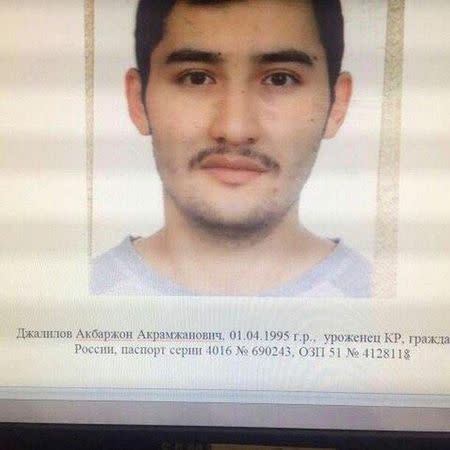St. Petersburg bomber executed amateurish, flawed attack - experts

By Jack Stubbs, Maria Tsvetkova and Christian Lowe MOSCOW (Reuters) - A Russian suicide bomber who killed 14 people in an attack on a St. Petersburg metro train conducted an amateurish, semi-bungled operation, probably with guidance but no direct support from outside backers, five security experts who reviewed publicly available evidence from the blast site told Reuters. Russian investigators on Tuesday identified the bomber as Akbarzhon Jalilov, from the city of Osh in mainly Muslim Kyrgyzstan, saying he had also left a bomb that was found at another metro station before it went off. That unexploded bomb, according to the experts who reviewed a photograph of it in Russian media, was a low-tech homemade device, made locally with sugar and other readily available ingredients, and an improvised, non-commercial detonator. This lack of sophistication points to a person, or persons, operating with limited resources but some guidance as to how to assemble an explosive similar to the kind used by militant groups such as Islamic State, the experts said. That supports the theory that Russia is facing a new kind of threat, from violent Islamists who blend into society and are not part of established jihadi groups, and are therefore much harder for security agencies to track down. "It suggests they were a fairly amateur organisation that wanted to do something but didn't have the contacts, money or the wherewithal to go and get some high-grade explosive," said a former Western defence official with experience of working with improvised explosive devices in the Middle East. The Western official and other people interviewed for this article spoke on condition of anonymity due to the ongoing investigation into Monday's attack. A Russian security service officer said the bomb was made using methods brought to Russia from Syria, and the explosive was known as "chocolate" because of its brown colour. "In contrast to the typical mixtures previously made (in Russia), Islamic State use sugar and the explosive has this earthy colour," he said, adding that it was likely "other people" were behind Jalilov's actions. Russian media have cited law enforcement officials as saying Jalilov had radical Islamist links, raising the possibility that his attack was inspired by Islamic State, which has never struck a major Russian city. Russia's Investigative Committee, the state body leading the investigation, did not immediately respond to a request for comment. So far, no-one has claimed responsibility for the blast, but Russia has been on alert for attacks in response to its actions in Syria, where it is supporting troops loyal to President Bashar al-Assad against Western-backed armed groups as well as hardline Islamists. Islamic State has repeatedly threatened revenge and been linked to attacks elsewhere in Europe. If it is confirmed that the metro attack was linked to radical Islamists, it could provoke anger among some Russians at Moscow's decision to intervene in Syria, a year before an election which President Vladimir Putin is expected to win. SOMETHING WENT WRONG A Western forensic explosives expert said the bomb was possibly made by mixing sugar or fuel with ammonium nitrate, which could be linked to an Islamic State grouping, but not any particular faction. "Often diesel is used for this, and that could produce a dark brown-coloured explosive. Many of the homemade main charges recovered in Iraq and Syria use (this method)," he said. Whatever Jalilov's methods, all five sources said one thing was clear: the bomber's plan went awry. The bomb recovered at St. Petersburg's Ploshchad Vosstaniya metro station, a short distance from the blast site, was likely left on a timer but failed to explode because the detonation mechanism was faulty or set incorrectly, said Neil Gibson, a senior weapons analyst at Jane's. The other sources said problems mixing the explosive could have resulted in a dud bomb, indicating rushed and inexpert assembly. "When you are going to blow yourself up, you need to ... test the mixture. It's very hard to get it right," said the former Western defence official. "If they didn't have enough time to get the mixing right, it could easily explain why that bomb didn't go off." Gibson said an analysis of pictures from the blast site also suggested the main attack had not gone to plan, with a weak blast inflicting little damage on the train carriage. Irina Avidon, a St. Petersburg resident who was travelling in the metro carriage next to the explosion, told Reuters the rest of the train was unaware a bomb had gone off. "There was a bang, quite loud but not extremely. A hatch flew up from the floor and sparks came out, there was smoke but it wasn't dense, everything was visible in our carriage," she said. "The train arrived in the station and we got off. At that moment, when I saw the torn-up neighbouring carriage, everything became very scary." The weak blast and small amount of physical destruction means the charge Jalilov used was small or the bomb was badly designed, Gibson said, citing possible problems with the shape, detonator and composition of the explosive. Jalilov's decision to detonate in the middle of the day, when the metro was relatively empty, is a further sign the attack was poorly executed or compromised, Gibson added. Russia's Kommersant newspaper on Tuesday cited a source as saying security services had been tipped off about the planned attack and were closing in on the suspects. "If the first (bomb) was a suicide device, as it seems to be, then it may have gone off early due to some error in construction," Gibson said. "Or the person thought they were being followed, so detonated the device as soon as they thought they could and still kill as many people as possible." (Additional reporting by Polina Nikolskaya; Editing by Giles Elgood)

